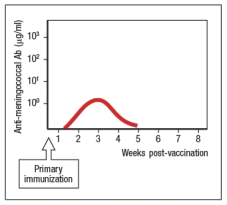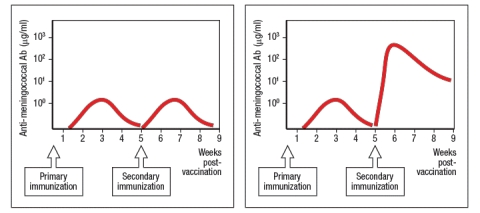MPSV-4 is a tetravalent polysaccharide vaccine designed to elicit antibodies to four different serotypes of Neisseria meningitidis, a bacterial infection that causes meningitis and sepsis in susceptible individuals. However, the protection induced by this vaccine is short-lived, and normally wanes to undetectable levels by 2-3 years post-vaccination. In addition, MPSV-4 does not induce mucosal immunity to Neisseria meningitidis; instead, it only protects against bacteria that access the bloodstream. Two newly developed vaccine candidates (A and B) are tested in mice for their ability to elicit high concentrations of anti-meningococcal antibodies that would provide mucosal as well as bloodstream protection. Also, the ideal candidate vaccine should also provide long-lasting immunity to the infection. Figure Q29)A is a diagram of the results from the primary immunization with both candidate vaccines: 
a) what is the predominant antibody isotype elicited by the primary immunization with these candidate vaccines? In which part of the body is that antibody primarily found?
Figure shows the responses to a primary, followed by a secondary immunization to each of the two candidate vaccines. 
b) Which candidate vaccine elicits the preferred response? What are the three aspects of the preferred response that make it the candidate vaccine of choice?
The vaccine developers refuse to divulge the components of the candidate vaccines A and B.
c) What is the likely composition of each vaccine and what evidence from the information above are used to lead to your conclusions?
d) To confirm the choice of the preferred candidate vaccine, what type of additional information from the vaccine trials in mice shown above would support this conclusion? Name two additional features of the secondary antibody response to each candidate vaccine that could be assessed, and what results would be expected for each of the candidate vaccines.
e) To assess whether either candidate vaccine might provide mucosal immunity in addition to immunity in the bloodstream, what feature of the response to each vaccine should be examined?
Definitions:
Net Cash
The amount of cash available after accounting for cash inflows and outflows, providing a clear picture of an entity's liquidity.
Investing Activities
Transactions and events that involve the acquisition or disposal of long-term assets and investments by a company.
Financing Activities
Transactions that result in changes in the size and composition of the equity and borrowings of a company.
Direct Method
A cash flow statement preparation approach that lists major classes of gross cash receipts and payments.
Q1: Defect in B cell maturation at the
Q3: The signaling pathways triggered by Toll-like receptors
Q5: In addition to producing distinct innate responses
Q7: Expressed on many cells types,its cytoplasmic tail
Q8: T cells expressing <span class="ql-formula"
Q11: Which of the following is the generative
Q13: What is Log10 of the forecast for
Q25: When mice are born, their intestinal lamina
Q33: A variety of genetic defects can result
Q63: i. A typical monthly seasonal index of